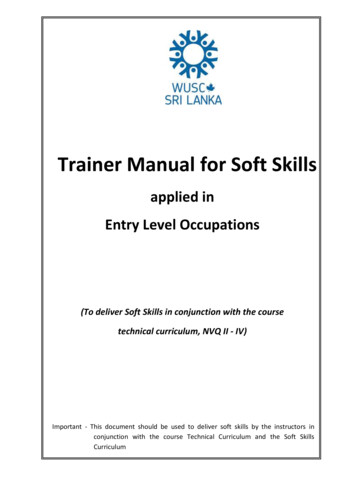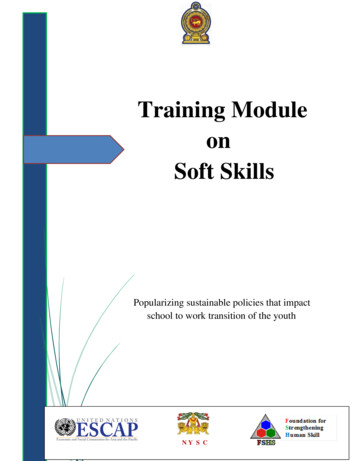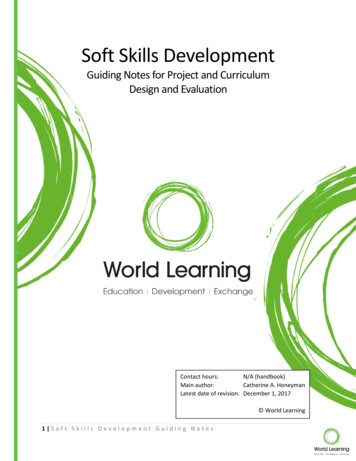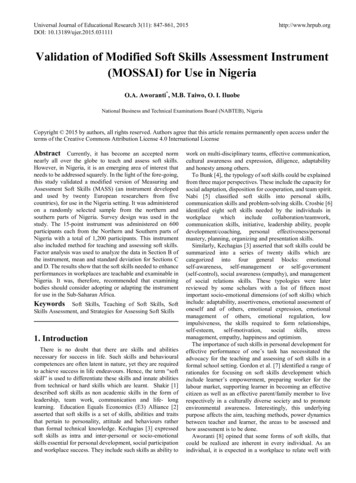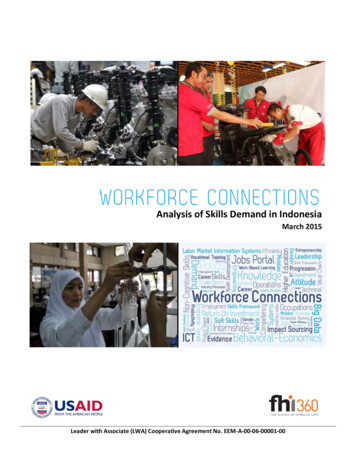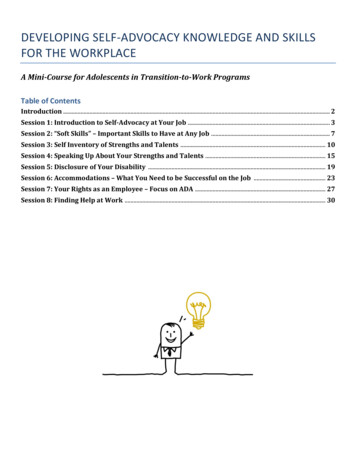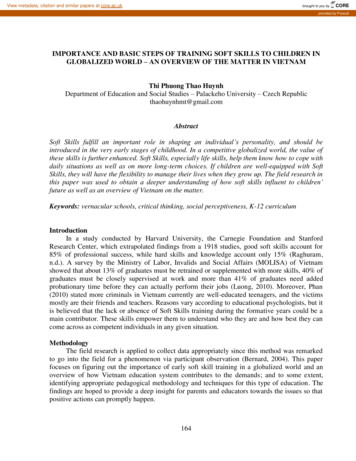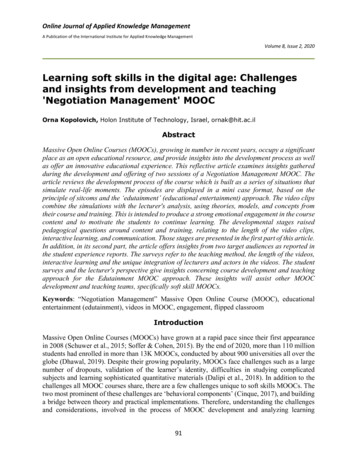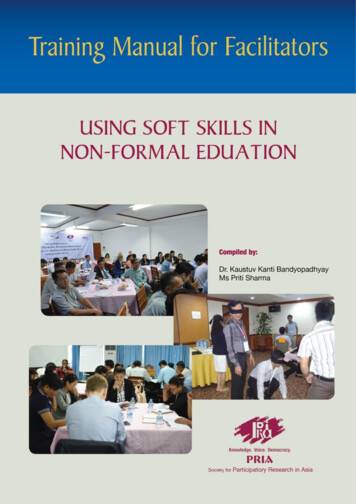
Transcription
PRIA and DVV International 2016All contents of this publication are the sole and exclusive property of PRIA, India andDVV International, Germany and may be treated as such. Any reproduction,publication, adaptation, translation, modification, extraction, import or export of thewhole or any part of this work, without the express written consent of parties, asmentioned, shall be deemed to be an infringement of its copyright. Such act(s) maybe subject to the imposition of severe civil, criminal and/ or other liabilities underapplicable law(s).First published by PRIA in January 2016Publication of this document has been supported by:Published by:Society for Participatory Research in Asia (PRIA)42, Tughlakabad Institutional AreaNew Delhi – 110062 IndiaTel: 91-11-2996 0931/32/33Fax: 91-11-2995 5183Email: info@pria.orgWebsite: www.pria.or1
CONTENTSAcknowledgement3About the Training Manual4Understanding Soft Skills and their Applications in Non-Formal AdultEducation5Perspectives on Participatory Training and Adult Learning7Understanding Methods of Participatory Training15Understanding Self using transactional Analysis35Egogram and Life Positions Questionnaire39Understanding Team and Team Building : Broken Square Exercise43Reading on Team and Team Building48Understanding Leadership : Tower Building Game57Reading : Understanding Leadership Development60Understanding Decision Making64Reading on Decision Making in Organisations70Understanding Interpersonal Communication75Reading on Effective Communication in Organization77Understanding Collaboration and Conflict in Teams82Reading on Handling Group and Organisational Conflict852
ACKNOWLEDGEMENTTraining Manual for Facilitators: Using Soft Skills in Non-Formal Education, isdeveloped through joint collaboration of Society for Participatory Research inAsia (PRIA), India and DVV International, Germany.This manual adapts a number of reading materials from the Manual onParticipatory Training Methodology developed by PRIA. We would like toacknowledge all the colleagues at PRIA and its partner organisations who havecontributed to different editions of PRIA’s manual for Participatory TrainingMethodology.Special thanks are due to Dr. Rajesh Tandon, President, PRIA for his ongoingsupport and guidance. We would also like to extend our sincere thanks toDr. Uwe Gartenschlaeger, Regional Director of DVV International’s RegionalOffice for South and South East Asian for his encouragement and supportextended to us for writing this manual.We would also like to thank regional partners of DVV International’s South andSouth East Asia office for extending support to us in the application of thismanual during trainings on using soft skills in non-formal education based onwhich this manual is prepared.Finally, we wish to acknowledge the support of all the colleagues at PRIA whohelped in putting together this manual.Dr. Kaustuv Kanti BandyopadhyayMs Priti Sharma3
ABOUT THE TRAINING MANUALThe Training Manual for Facilitators: Using Soft Skills in Non-Formal Education,is developed to address the needs of those trainers and facilitators who areengaged in non-formal education sector. This manual is designed to: Build an understanding on the concepts of soft skills in non-formal education A reference manual for the practicing trainer of using soft skills in non-formaleducation training A source book for sample training sessions, materials and exercises to beused during such training. It comprises of steps and activities for facilitatingtraining on soft skills.This manual covers references and practitioners’ note to facilitate the sessions.The users of this manual can add references and local stories to make it morerelevant and contextual for their own specific areas. This manual is based on theparticipatory training methodology developed over decades by the practitioners inPRIA and its partner organisations.This manual is divided into two sections. Section 1 focuses on the relevance ofsoft skills in non-formal education and use of participatory training methodologiesin training on soft skills. Section 2 takes users through various sessions that canbe part of soft skills training.4
UNDERSTANDING SOFT SKILLS ANDTHEIR APPLICATION IN NONFORMAL ADULT EDUCATIONThe dictionary meaning of soft skills refers to the personal attributes that enablesomeone to interact effectively and harmoniously with other people. If we were tolook at some other definitions, soft skills refer to a cluster of personal qualities,habits, attitudes and social graces that make someone a good employee ormember of an organisation who is compatible to work with.Soft skills include work ethics, attitude, communication skills, emotionalintelligence and a whole host of other personal attributes. When talking about softskills it is inevitable to mention about hard skills. Hard skills refer to trade skillsand subject matter expertise, e.g. accounting, typing, operating machinery, etc.They are quantifiable and their application is universal. Hard skills are specificteachable abilities that are needed to perform a job.If we were to look at soft skills, some of the most important soft skills are: LeadershipDecision makingTeam workCommunication NegotiationConflict managementInfluencingTime managementWe can divide these skills further. For example, communication skills will includeverbal, written and non-verbal communication, presentation skills etc. Influencingskills will include facilitation, motivation and negotiation among others. Personalskills can be further divided into skills related to Emotional Intelligence, StressManagement, Self Confidence, Resilience, Assertiveness, Friendliness andEnthusiasm to name a few. In this manual, however, we will focus onUnderstanding Self, Leadership, Decision Making, Team Building,Communication and Conflict Management.In the recent years, emphasis on importance of soft skills has grown all over theworld. It is not only important to know technical aspects of a job but how thisknowledge will transform into output has also become very important for theorganisations. A person’s behaviour, attitude, communication skills etc. play animportant role not only in employability but also the importance of such skills incareer growth. In today’s context, no person is working in isolation. We are allconnected to each other in a given job scenario. In this context if a person hasexcellent knowledge of her/his subject but doesn’t have good relationship with theteam and also unable to lead the team to complete a project, the work will getaffected leading to dissatisfaction among all concerned.5
Let’s take a look at the importance of soft skills in non-formal education. If wewere to go by the definition of non-formal education, it essentially is “anorganised educational activity outside the established formal system that isintended to serve an identifiable learning clientele with identifiable learningobjectives”.1On many occasions non-formal education addresses the gaps in employabilityskills. With the growing importance of soft skills, employers also tend to focus onsoft skills and assess these through various tests available.Under such circumstances incorporation of soft skills needs to be acknowledgedby professionals working on non-formal education. This will ultimately facilitatebetter working environment leading to improved productivity.Further resource links for reference:The Pickle Jar Theory by Jeremy Wright (http://alistapart.com/article/pickle)Why Soft Skills Matter /socdev/unyin/newsletters/2011/YouthFlashJune20116
PERSPECTIVES ON PARTICIPATORYTRAINING AND ADULT LEARNINGPerspectives on participatory trainingTraining has always been viewed as a learning process - learning of new skills,concepts and behaviour. As such it is an educational activity. However, it isusually viewed as distinct from formal education, like schooling. In general,training implies non-formal education of adults, but in a purposive, directedsense. Training also connotes a structured event, with boundaries of time, placeand persons.The traditional meaning of training has been the transfer of expertise from trainerto learner, where the trainer defines what a particular set of learning the learnersneed to learn. This approach to training believes that trainers know everything,and the learner is looked upon as an empty container to be filled up by thetrainer. Learners play a passive role and are bound to learn what the trainerteaches.This training approach does not allow learners to participate actively, and givestotal control over the process to the trainer. Everything in this type of training fromdefining the objectives to evaluating the learner is done by the trainer. The choiceof training methods is based upon the trainer’s preference and convenience, andresults in a predominance of lectures. The emphasis is on subject matter, orcontent, and the trainer’s competence is ensured if she/he is a subject matterspecialist. This approach to training is very close to formal education orschooling.Major assumptions in traditional training methodology Acquisition of subject knowledge by learners will automatically lead to action,or change in behaviour;The trainer ‘owns’ the knowledge and can therefore transmit or impart it as‘instructor’;Learning depends essentially on the trainers’ teaching capacity and thelearners’ learning capacity;Training is the responsibility of the trainer and the training institution;Knowledge, and training, are value-neutral and ‘objective’.An alternative view of training has evolved over the second half of the 20thcentury in which it is not limited to ‘transfer of expertise’ or equated with‘imparting knowledge’. Training is seen as a process of growth and discoveryaimed not just at ‘knowing more’ but at ‘behaving differently’. The focus is onbuilding up one’s critical consciousness, examining one’s values, attitudes andorientations; on ‘unfreezing’ set notions and set patterns of behaviour, and7
questioning, re-thinking, and re-learning. It is a non-formal, on-going process, inwhich both trainers and trainees learn from each other. This approach to trainingis intended to build the learners’ confidence in their capacity to observe, criticise,analyse, and figure things out for themselves. Thus, learners discover they arejust as good as their trainers and everyone else. They learn to cooperate, ratherthan compete, for the trainer’s approval. Learners are encouraged to consider thewhole social context and past history when they try to understand realities of theirsituation. Their learning revolves around their own needs, and progressesthrough opportunities for reflection and analysis.This approach can be called training for change. Emphasis is more on learningthan on training. Learners are encouraged to voice their own ideas and exploreways to solve their problems, investigate their own reality on the basis of theirown experience. This approach to training aims at freeing people from patterns ofthinking imposed upon them by dominant forces. Its methodology is learnercentred, experience-based and open-ended.Major assumptions in alternative approach to training 2People cannot be developed; they can develop themselves.Acquired knowledge does not automatically lead to action or changedbehaviour, people first need to be convinced about the importance of change.Learners themselves are a rich source of information and knowledge aboutthe real world.The collective is a powerful tool for learning and change.2Training and knowledge can never be neutral .The purpose of training is to influence behaviour and attitude. In Participatory Trainingthe facilitator influences the learners to learn new perspectives and behaviour towards theissue in discussion. In such learning situation the facilitator also brings her/his perspectiveand experience in the discussion. For example, if a training is focussed on addressingviolence against women, the learning group cannot remain neutral. They are expected toraise their voices and also work with others to end this practice.Participatory Training is an educational strategy based on the alternativeapproach described above. Learners are active participants in the educationalprocess, and their needs and questions, their reflection and analysis, and theirstrategies for change carry the process forward.It is important to realise that Participatory Training is not just a set of techniques.It functions in a certain historical, socio-political context. The ideological bias ofParticipatory Training needs to be understood clearly, otherwise the methodologycan get reduced to a set of tricks and gimmicks. We need to be aware of theconstant danger of co-option, where similar words and activities are used but thehidden intention is basically to make people conform and accept control.8
Participatory Training aims at creating an experience of personal and collectivechange, thus strengthening people’s understanding that change is possible,within one’s self and at the level of the group.Participatory Training encourages people to question what they have alwaysaccepted, to critically examine their own experiences, to derive insights throughanalysis. This process of releasing people’s critical faculties enables them todiscover and exert their latent powers for autonomous constructive action.Participatory Training recognises and validates authentic and accurate people’sknowledge which is based on the experience of reality, and synthesises it withfresh insights and restructured concepts based on the analysis of experience.The new body of knowledge thus created leads to a powerful sense of ownershipand a willingness to transform the reality. Learners thus become prepared foraction.In conclusion however, it must be mentioned that the role of ParticipatoryTraining in bringing about change has some limitations.Firstly, structures and systems of society do not change within the trainingprogrammes. Individuals can understand social dynamics and social change,their potential role in the process of change, assess their strengths andweaknesses, acquire relevant skills to play a meaningful role and appropriatevalues necessary to build an alternative society. Groups can learn how tofunction as an effective unit for action, and groups can experience in amicrocosm, the possibilities of democratic functioning in an egalitarian society.But all these, notwithstanding, structural transformation can never be broughtabout through training alone. Additional important steps outside the trainingcontext are needed for social change.Secondly, while working towards change with poor, downtrodden, illiteratepeople, there is a great temptation to define change for them. As such, theeducational intervention basically mobilises support for a particular cause that weconsider 'right'. We can skilfully manipulate their thinking so that they startbelieving it is their cause. In this we become equally guilty of mind-control as anyother oppressive power. Participatory Training may create informed options forthe learner, but it gives the learner the option to accept or reject any option.If learners are helped to discover and develop their inner resources through anenvironment providing opportunities to use their abilities, they will demonstrate anincreased capacity to manage their lives. We need to trust them to do this. Ourresponsibility is to help learners achieve a “raised consciousness” and to liberatetheir latent powers of independent thought and inquiry, so that they begin to viewthemselves as creators of ideas and initiators of action.Participatory training and adult learningParticipatory Training deals with adults, and as such, has its theoretical base inthe principles of adult learning. According to these principles, adult learning takes9
place in a different way, and under different conditions, from those of children'sformal school education. Ineffectiveness of programmes for adults may havepartly to do with lack of understanding about the various principles and conditionsof learning. Those who try to make adults learn in an environment similar toformal school and by the same methods sometimes end up believing it isimpossible to bring about any change in adults. Another common misconceptionis that most learning takes place through childhood and stops after adolescence,and that it is impossible to alter this learning afterwards.Contrary to such beliefs, people learn, grow and change even in adult life.Effective adult learning takes place when the essential characteristics of theirlearning mode are operationalised as principles guiding the process. There arefive key principles:A. Adults come to the learning situation with a well-defined self-concept, andtheir learning can be facilitated by helping them to build up their self-concept.If the self-concept is low, the learner thinks that she/he is incapable, ignorant,inexperienced and powerless. This blocks new learning. This self-concept mayhave been conditioned by adverse circumstances, by marginalisation andexploitation. If the learner is helped to overcome this low self-concept andrecognises that she/he is capable, has some thing to contribute and has thepotential to learn, she/he becomes more open to the learning process. Similarly,an unrealistically high self-concept may also block learning.B. Adult learning is an emotional experience, both in the sense that certainemotions are associated with learning, and that learning occurs throughfeeling as much as thinking or acting.All changes entail risk. Thus, the act of learning creates anxiety, stress, perhapsfear, frustration or helplessness. This needs to be understood and handled withsensitivity, especially when dealing with those who have never been to schooland are very apprehensive about the learning situation. Moreover, feelings assuch are an important mode of learning, a basis for learning, and a vehicle oflearning. We avoid what angers us, or frightens us, or what we are contemptuousof. Conversely, we are eager to find out more, learn more, about the things forwhich we have positive feelings.C. Adults choose whether to learn or not.Adult learning is volitional and autonomous. Forced learning does not last. Adultsneed to be interested and ready before they learn something. If they have comenon-voluntarily or as a result of external demands, they will need extra support,encouragement and guidance. Learning improves when self- directedness isencouraged, when learners are involved in planning and monitoring the process.Interest can be heightened by feedback on progress in the desired direction oflearning.10
D. Adults learn what they think is relevant to their lives and their problems.Unlike children's learning which is for postponed application, adults want to learntoday what they can apply tomorrow. Hypothetical problems, or content areas farremoved from their reality, appear a 'waste of time'. Learning is easier when itinvolves practical material related to current or perceived future concerns of thelearner.E. Adults learn based on experience.Adults come to a learning situation with a rich storehouse of past experiencewhich can be both a potential learning resource or an unavoidable hindrance, forpast experiences determine how a learner interprets new experiences, and howshe/he learns. Moreover, adults equate experiences with themselves, theirunderstanding of the meaning of life. Devaluing or ignoring adults' experience istantamount to a personal rejection. Sharing of experiences by learners andtrainers, and giving value to past and present experiences, creates a readinessfor new learning.Adults prefer learning 'relationally', that is, perceiving how facts relate to reality,rather than memorising facts. Effective learning occurs when adults use past orpresent experience to gain a deeper understanding of their reality, and thusprepare to encounter fresh experiences.Importance of building a learning environment in participatory trainingLooking at the principles of adult learning, it becomes evident that a speciallearning environment is essential for adults to learn effectively.A learning environment is not given to the trainers, it has to be created, built,sustained and nurtured by the trainers. In the context of our learners and thelearning process, the challenge of building and sustaining an environment thatwould facilitate both individual and collective learning, that would facilitate aprocess of questioning, critiquing, and reflection becomes very crucial, and astrainers we have to create conditions for the principles of adult learning tobecome operationalised. Some of the key characteristics of the learningenvironment are:A. Valuing learners and their experiencesA fundamental aspect of the learning environment is valuing the learner, valuingher/his uniqueness, experiences, contributions, knowledge, and capacity to learn,grow and change. Valuing and respecting the learner becomes the hallmark ofcreating a learning environment and this valuing has to be demonstrated by theactions of the trainer, by the conditions created in the training and not by emptywords alone. This involves that the trainers, both during formal (during theplanned and structured training sessions) and informal sessions (discussion thattakes place outside the training sessions), pay keen attention to the learners, tryand understand what they are saying and sharing, and how support is beingprovided to the learners.11
B. Sharing personal experiencesSince adults learn from their experience, conditions have to be created for aneasy, open, systematic and effective sharing of their past experience. Sharing ofexperience doesn't mean endless, open-ended story-telling sessions. Sharinghas to be focussed in relation to specific learning objectives and thereforestructured in a way that learners find the opportunity to share their experience inrelation to those learning objectives with other learners and the trainers. This iswhy the task of facilitating small groups sharing, expressing, opening up,articulating, listening to others, caring for others, becomes an important one. Thepurpose of sharing is also to promote critical analysis and be challenged toexperiment with new ideas, feelings, behaviour and action. Mutual sharingprocess involves not merely learners’ sharing, but the trainers also sharinginformation about themselves and their experiences.C. OpennessAnother principle of the learning environment is openness. Openness to oneself,openness to others, openness to learn, openness to question, openness toexamine, openness to observe. Conditions have to be created so that learnersand trainers can be open with their thoughts and their feelings and they can beopen with their actions – open with themselves in the privacy of oneself and openwith themselves in the presence of some others and open with others, on theirface. This is important because learning occurs in relation to others, with thesupport of others, in the process of reflecting on oneself, on others and on thesituation. For example, a training on addressing violence against women with thesurvivors of violence will require a safe and open environment where they canshare their deep personal experiences with the objective to change their lives.D. ChallengingThe next characteristic of learning environment is that there should be achallenge to the learners. Learners should be provoked, stimulated, cajoled, andchallenged. It is not a passive environment; it is not doing your own thing; it isquestioning, critiquing, asking, stimulating, and provoking. Creating conditions forpeople to be stimulated, to stretch themselves beyond their immediate capacity,to utilise their potential creatively, to utilise their capacity, to unfreeze themselves,to realise their critical faculties.E. SafetyAnother key characteristic of the learning environment is psychological safety andcomfort. The learner should be challenged but not be dumped upon. The learnershould be stimulated and provoked but never undermined. The learner should bequestioned, but not demolished. A sense of psychological safety – I can bemyself, I can say to myself, I can look at myself, I can try myself, I can makemistakes myself and yet be acceptable to and by others, is an essential aspect ofthe learning environment. Safety issues are also related to the security provided12
in and by the group. This facilitates opening up, taking risks, and sharing aboutoneself.F. SupportA related aspect, therefore, is support – emotional support, intellectual support,behavioural support –and availability of support – individually available, availablein small groups, creating conditions so the learners are supporting each other asmuch as the trainers and facilitators are supporting the learners and themselves– support in action and not as a verbal exercise. Support needs to be providedboth during the sessions and outside the sessions. Support also needs to besolicited from the learners by trainers.G. FeedbackAnd finally, the learning environment must have conditions built in for feedback –for information to come back to the person and to the group. Throughmechanisms which are easy and relaxed, and not constrained and difficult;feedback from each other, from self, in unobtrusive ways, from the trainers andthe learners, continuous feedback on one's thoughts, emotions and actions; onwhat one has learnt and what one has attempted.In brief, these are some of the key characteristics of an effective learningenvironment. In order to build it and sustain it, there are several things a trainerneeds to do: The design of the training should be such that it helps in building theenvironment all the time keeping learners involved. It means the subjectmatter and the learning methods should be relevant to the learner. Shared responsibility for learning by the learners; involving the learner,soliciting their support, commitment, responsibility, feedback towards buildingand maintaining the learning environment, supporting their roles asfacilitators, counsellors, friends with their peer groups. Physical aspects of the training, ensuring that all physical, administrativeaspects (food, travel, etc.) of training are well coordinated and managed anddo not cause stress and anxiety of any kind of the learners. Even small thingslike the cleanliness and organisation of the training room, advancepreparation/installation of technical aids, organising small rooms for groupexercises, noise effects, too much movement in the room (people coming andgoing, etc.) become important issues for the trainers to ensure that thelearners do not get disturbed or have to fend for themselves in the process. Most importantly, the trainer's behaviour becomes a significant contributor tothe learning environment. Knowledge of training design alone is not enough,their understanding about themselves is crucial –their perspectives, values,behaviour and action – how do they respond to learners, how do they care,what effort they put into the content areas, how do they enhance the self-13
esteem of learners, etc. All these set the normative structures for the training.What do they do to set up the others in the training? What do they do to setup the learning environment? All these have implications of what the learnerswould do, when they go back from their training centre.The conditions for learningAn environment of active people – People learn when they feel they arepersonally involved with others in a learning process.A climate of respect – When a high value is placed on individuals and a senseof caring prevails.A climate of acceptance – Accepting a person means that she/he can beherself/himself and express her/his beliefs without fear.An atmosphere of trust – When people have a feeling of trust in themselvesand in others.A climate of self-discovery – When learners are helped to find out aboutthemselves and to meet their own needs, rather than having their needsdictated to them.A non-threatening climate – So that persons can confront each other andideas without fear.A climate of openness – When personal concerns, feelings, ideas and beliefscan be expressed and examined openly.An emphasis on the uniquely personal nature of learning – When eachindividual knows that her/his values, beliefs, feelings and views are importantand significant.A climate in which differences are thought to be good and desirable – Whendifferences in people are as acceptable as differences in ideas.A climate which recognises the right of individuals to make mistakes –Learning is facilitated when error is accepted as a natural part of the learningprocess.An atmosphere that tolerates ambiguity – When alternative solutions can beexplored without the pressures of having to find an immediate single answer.An emphasis on co-operative evaluation and self-evaluation – When peoplecan see themselves as they really are, with the help of their peers.This section has been adapted from “A Manual for Participatory Training Methodology inDevelopment”, Sixth Edition 2011, published by the Society for Participatory Research in Asia(PRIA), India.14
UNDERSTANDING METHODS OFPARTICIPATORY TRAININGHow do we select appropriate learning-training methods that will best convey thecontent areas of the training programme? In the traditional view of training,lectures are a favoured method for conveying any subject matter. With moreprogressive modes of training we have group discussions. Some programmes listslide shows and video films as methods.In Participatory Training, a wide range of methods exist to suit the basic criteria ofeffective learning, learner involvement and sustained interest. We can briefly lookat the methods, reflect upon the principles of method selection, and then studyeach method in depth, noting the procedure, adv
A reference manual for the practicing trainer of using soft skills in non-formal education training A source book for sample training sessions, materials and exercises to be used during such training. It comprises of steps and activities for facilitating
